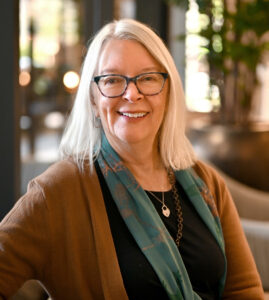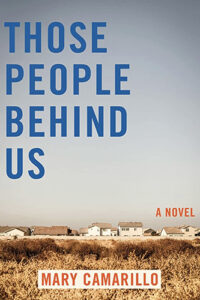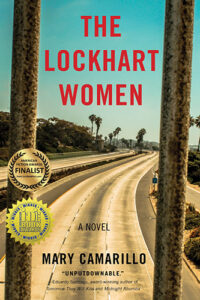Searching for Home and Community: An Interview with Mary Camarillo
 I first crossed paths with author Mary Camarillo back in 2021, upon the launch of our debut novels. Since then, thanks to social media, of course, we’ve stayed somewhat connected. I was thrilled to know she had another book coming out this year, and even more thrilled that she agreed to a second interview. Those People Behind Us, which made the 2023 Hawthorne Prize short list, launched in October and is doing very well. Suzanne Simonetti, USA Today best-selling author of The Sound of Wings, said of the book, “Juxtaposed against the bright and sunny Southern California sky, this multigenerational tale takes a deep dive into the minds and motivations of a seemingly harmless neighborhood as it strips back each dark and complicated layer, piece by piece,” and one Goodreads reviewer wrote, “An honest and thoughtful portrayal of American society in divisive times, the novel also offers hope that by finding the humanity in our neighbor we can find common ground and acceptance.” It’s still on my TBR list, and I’m hoping to get to it by the end of the year. Many thanks to Mary for finding time in this hectic season to answer my questions!
I first crossed paths with author Mary Camarillo back in 2021, upon the launch of our debut novels. Since then, thanks to social media, of course, we’ve stayed somewhat connected. I was thrilled to know she had another book coming out this year, and even more thrilled that she agreed to a second interview. Those People Behind Us, which made the 2023 Hawthorne Prize short list, launched in October and is doing very well. Suzanne Simonetti, USA Today best-selling author of The Sound of Wings, said of the book, “Juxtaposed against the bright and sunny Southern California sky, this multigenerational tale takes a deep dive into the minds and motivations of a seemingly harmless neighborhood as it strips back each dark and complicated layer, piece by piece,” and one Goodreads reviewer wrote, “An honest and thoughtful portrayal of American society in divisive times, the novel also offers hope that by finding the humanity in our neighbor we can find common ground and acceptance.” It’s still on my TBR list, and I’m hoping to get to it by the end of the year. Many thanks to Mary for finding time in this hectic season to answer my questions!
Christina: It’s great to have you back on the occasion of your second novel, Those People Behind Us. Can you tell us a little bit about that fantastic title? When in the writing process did the title come to you?
Mary: I knew early on I wanted to call this novel “Those People Behind Us.” This book is set in a neighborhood in a fictional suburban coastal town called Wellington Beach, based on a housing tract where I live in Huntington Beach, California. “Those people” is an expression I find myself using all too frequently about the people around me.
The characters in the novel also use this expression. One character is sure that “those people” in his neighborhood judge him for driving a sixteen-year-old Camry. One believes “those people” at his gym judge him because he’s living in his car. Another is concerned about “those people” her husband is determined to make friends with because she’s uncomfortable with their opinions.
Christina: The story features an ensemble cast, which you’ve said was inspired by people in your neighborhood. How did you go about bringing these characters to life? Does one character have a larger voice than the others? Is one character your favorite?
Mary: I’m a people watcher and an eavesdropper and use what I observe and overhear in my fiction. There are five main characters in this novel. They are all neighbors. Keith is an ex-con who is living in his car and often parks around the corner from where his parents live. His character is based on someone I watch at my gym. Ray is a Vietnam veteran who is taking care of his aging mother. He reminds me of friends who served in Vietnam during the sixties.
Jeannette is an aerobics teacher who is haunted by a horrific tragedy. Her character is based loosely on an aerobics teacher at my gym. Sixteen-year-old Josh deals with his father’s abandonment by slamming on a drum set. When I was a kid I wanted to play drums so I channeled that dream into Josh.
Lisa is a real estate agent, who has a slightly larger voice in the story, because she constantly walks the neighborhood, keeping her eye on property values. I’ve always thought real estate agents had an insider view and enjoy their newsletters and their promo notepads. I even wrote newsletters for Lisa.
Keith is one of my favorite characters because he is so damaged and troubled and still trying to do the best he can with his life. But I love the entire cast. Ray is a grouch but he is tender with his mom. Jeannette finds some comfort in her color-coordinated closet and her purses. Josh loves rock and roll as I do. And despite all the cringeworthy things that Lisa thinks and says, she only wants the best for her family.
Christina: Connection and belonging are themes of Those People Behind Us. What about those themes is so important to you? Why write about them?
Mary: The neighborhood where my characters live is increasingly divided by politics, protests and escalating housing prices, as so many neighborhoods are these days. This is a town where everyone is searching for home and community, and no one can agree who belongs. Some of the characters don’t even believe they belong where they live.
Keith, estranged from his family, is lonely. Ray is astonished at how much his neighbors’ cars cost, more than he ever earned in a year. Jeannette is so numbed by tragedy she doesn’t believe she belongs anywhere in the world. Josh is sure his neighborhood is the most boring place in the world and can’t wait to grow up and move away. Lisa, the real estate agent, is focused on ensuring property values continue to rise and is adamant that the beach lifestyle she cherishes doesn’t change. She’s sure she knows who “belongs” and who doesn’t.
All the characters make assumptions about the people around them, without knowing or trying to imagine what might be going on in their lives. In the end, when they allow themselves to find a small amount of empathy, they realize they have more in common than they expected.

Christina: Unlike your debut novel, The Lockhart Women, Those People Behind Us is a set of linked stories. Did you set out to write a set of stories, or did that form arise organically? How did the writing process differ for each of the books? Was one form more challenging than the other?
Mary: I actually set out to write a murder mystery but none of my characters in the second novel were interested. I always start with characters and then give them lots of trouble and see how they resolve, or don’t resolve, their problems. I know I’m on to something when they start telling me what story they want to be in.
I’m definitely a “pantser,” meaning that I don’t use an outline and don’t know how the story will end until very late in the process. It’s good for a writer like me who is always in search of a plot to set some parameters. It was helpful with The Lockhart Women to frame the story around the O.J.. Simpson trials. Those People Behind Us takes place during the summer of 2017, and it is also framed around historical events—the solar eclipse and the Charlottesville Nazi march.
I love reading and writing multiple point of view stories because it allows a broader perspective of all the characters. There were three points of view in my debut novel. This book has five rotating points of view, as well as many secondary characters. It was a challenge to keep the voices distinctive. I spent a lot of time in everyone’s heads, figuring out how they saw the world and what they really wanted.
My first novel took seven years to write. Those People Behind Us took three years. I call it my pandemic book. Because the gyms were closed during those years, my husband and I walked our neighborhood a lot, seeking exercise and entertainment, and we made up stories about what we observed.
Christina: One of the things I find interesting is looking at comparable titles for books. What books would you consider comps for Those People Behind Us? What about movies or TV programs?
Mary: One of my favorite blurbs called this novel “Peyton Place with a twist of Trump.” Another reviewer said, Those People Behind Us was reminiscent of Winesburg, Ohio, by Sherwood Anderson, and the play Our Town, by Thornton Wilder. Others have said my work reminds them of Olive Kitteridge, by Elizabeth Strout, and Big Little Lies, by Liane Moriarty.
I found similarities with my work and two brand new releases. The Heart of it All by Christian Kiefer is about three families in a small town in Ohio searching for home and community. Céline Keating’s the stark beauty of last things concerns multiple characters in Montauk, New York, struggling with the town’s future and their own place in the world. I recommend both of them!
Christina: You published your first novel at sixty-nine years of age. Did you encounter any ageism in your journey to publication? Were your expectations about the publishing industry in general realistic?
Mary: Ageism is alive and well. Some folks like to pat me on the head and say how proud they are of me and ask if I would maybe like to sit down. But these days there are many vibrant human beings much older than me who are making wonderful art. Pick up author Stacy Russo’s new book, Beyond 70, The Lives of Creative Women, for some inspiring examples.
One advantage of age is hopefully developing a thicker skin. Publishing is competitive and often heart breaking and I try to keep my expectations low and my gratitude high, like my favorite Texas singer/songwriter Ray Wylie Hubbard advises. Another advantage of being of a certain age is having a pension, which means I write because I want to, not to support myself. I’m very grateful for my retirement annuity, although I worked almost forty years at the post office to earn it.
With my first novel, my expectations about the publishing world were not at all realistic. I didn’t know what to expect from a publicist, much less what to ask for. I didn’t know bookstores could order books and immediately return them. I had no idea folks could be so snarky on Goodreads. I wasn’t prepared to do elevator pitches, talk about “themes,” or explain what my book was “about.” I naively expected that people would simply read it and tell me.
I’ve learned a lot since my first publication. I’ve also learned to enjoy the ride a little more, and not check my Amazon rankings every five minutes.
Christina: Your writing has won or landed as a finalist in multiple awards. Does that factor into what literary success means to you?
Mary: Of course, I love shiny stickers and gold medals. It’s validation, which is wonderful in the lonely world of sitting at a desk all day, making up stories, hoping someone might read them. One of my favorite awards was being named winner of the 2023 Indie Author Project for California Adult Fiction.
Some readers are impressed by the awards and others could care less. But honestly, my favorite sign of success is when a reader reaches out to me personally and tells me how much they enjoyed my book. That’s the best validation.
Christina: Of course, we need to ask about your cat, Riley (which I neglected to do the last time you were here!). How is Riley doing? Any fun antics from this officemate? Please give us all the details!
Mary: Riley is eight years old now and just when I think he’s starting to slow down, he charges up and down the stairs, growling like a maniac. He still runs to the front door when anyone knocks because he believes he’s in charge and we’re not about to argue with him.
Riley is getting a little more resistant about posing for photos with books I want to promote on Instagram and I worry he’s ready to go on strike. I’m probably going to have to raise his catnip allowance.
Mary can be found in multiple places!
Website: http://www.marycamarillo.com/
Facebook: @marypcamarillo
Instagram: @marycamel13
X: @MarycamelMary
Thanks to Mary for agreeing to this interview! If you know of an author who’d like to be featured in an interview (or you are an author who would like to be featured), feel free to leave a comment or email me via my contact page.


